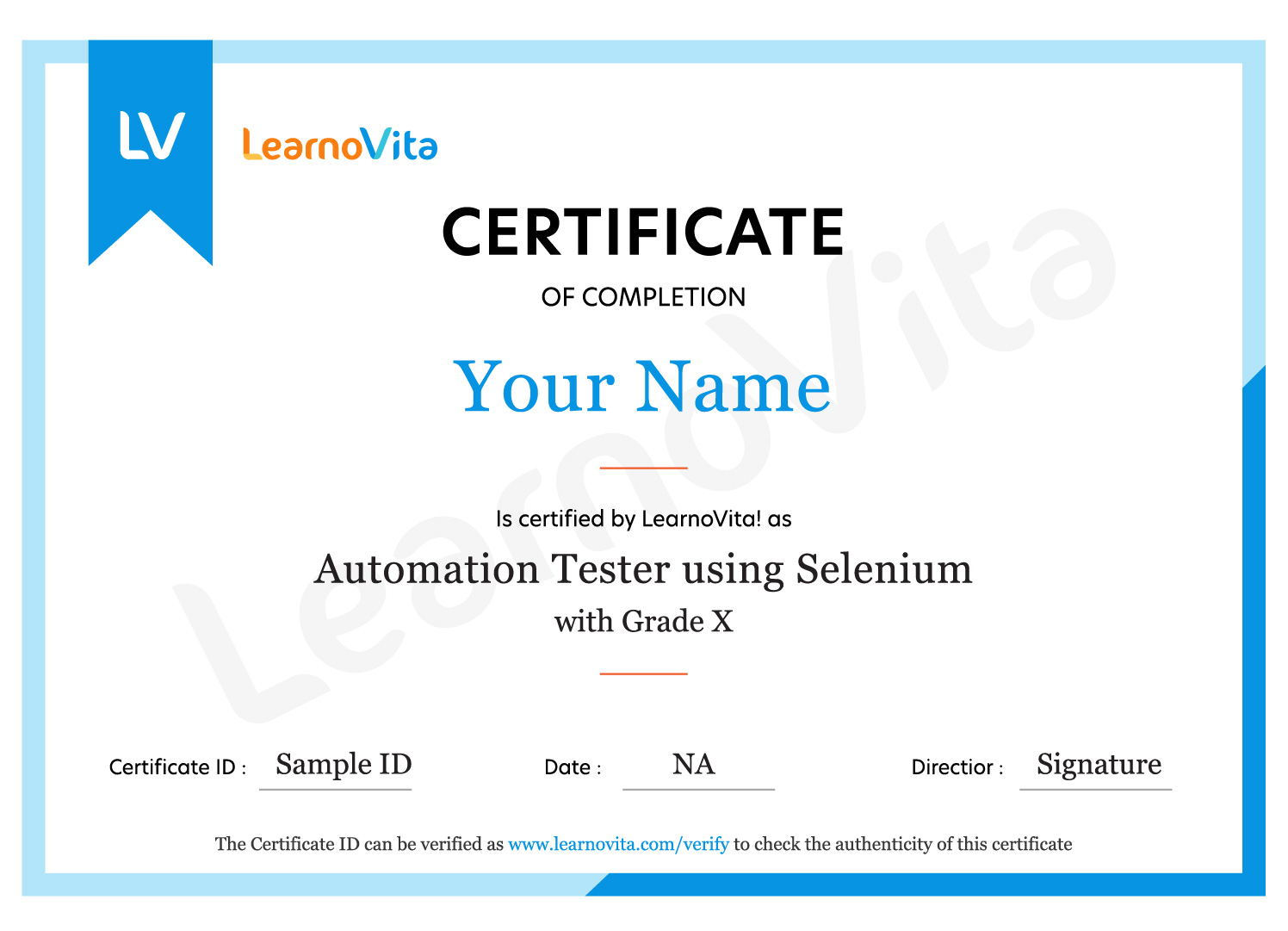What You'll Learn
Data Science Training in Anna Nagar provides comprehensive understanding of analytics and machine learning for practical problem-solving.
For precise business forecasting, comprehend the fundamentals of statistical analysis and predictive modeling.
Learn SQL, R, and Python to effectively handle big datasets and extract useful insights in Data Science Course in Anna Nagar.
Engage in real-time initiatives that include fraud detection, sales optimization, and customer behavior.
Create data visualizations and interactive dashboards using Tableau and Power BI.
Enhance your job prospects with industry-relevant experience and sophisticated data management skills.
Data Science Course Objectives
- Tensorflow.
- PyTorch.
- RapidMiner.
- DataRobot.
- Alteryx.
- Qubole.
- Paxata.
- Trifacta.
- Linear Regression.
- Logistic Regression.
- Decision Tree
- SVM.
- Naive Bayes.
- kNN.
- K-Means.
- Random Fores
- Apache Cassandra is a highly scalable open-source NoSQL database management system designed to handle large amounts of data quickly. GitHub, Netflix, Instagram, and Reddit, among others, use this popular database.
- Yes, SQL ( Structured Query Language ) is required for Data Scientists to obtain and manipulate data. Everyone is too busy to learn R or Python for data science, but data science is meaningless without a database.
- Dell EMC Proven Professional Certification Program.
- Certified Analytics Professional.
- SAS Academy for Data Science.
- Microsoft Certified Solutions Expert (MCSE).
- Cloudera Certified Associate (CCA).
- Cloudera Certified Professional: CCP Data Engineer.
- The average data scientist salary in the United States is $100,560, according to the US Bureau of Labor Statistics. High data science salaries are due to organizations realizing the power of big data and wanting to use it to make better business decisions.
- Analytics and big data have been identified as the next major growth drivers by Indian IT companies. Faced with a crowded global IT services market, Indian firms have begun to expand their analytics service offerings. This has resulted in a high demand for trained data scientists among IT firms.
- Data scientists are software experts who use tools such as Java, Hadoop, Python, and Pig. Their responsibilities include business exploration, analytics structuring, and data management. The main reason for Data Science's bright future is its high-end demand as a result of digitalization.
- Descriptive Analysis.
- Predictive Analysis.
- Diagnostic Analysis.
- Prescriptive Analysis.
Request more informations
Phone (For Voice Call):
+91 89258 75257
WhatsApp (For Call & Chat):
+91 89258 75257
Benefits of Data Science Course
With our Data Science Certification Course in Anna Nagar, which consists of expert-led seminars, project-based learning, and a targeted Data Science internship, you may realize your full potential.Develop in-demand analytical abilities and familiarize yourself with industry resources to get ready for jobs requiring you to solve problems in real time.Gain practical exposure through a structured Data Science internship in Anna Nagar designed to boost your career readiness. After finishing, you will have real-world experience, be prepared for the workforce, and have the self-assurance to succeed in a career in data science.
- Designation
-
Annual SalaryHiring Companies
About Your Data Science Training
Learn statistics, data analysis, and visualization techniques in an affordable Data Science Certification course with professional instruction and practical exercises.Through our Data Science Course in Anna Nagar, we offer Data Science course with placement aid and internship exposure to more than 500 recruiting partners.Learn Python, SQL, and machine learning firsthand so you can confidently create data-driven solutions.Accessibility is guaranteed by reasonable Data Science course fees, and obtaining a respected certification will advance your professional path.Work on real-time Data Science projects in Anna Nagar to gain practical experience and industry-ready skills.
Top Skills You Will Gain
- Data Wrangling
- Predictive Modeling
- Statistical Analysis
- Machine Learning
- Data Visualization
- Programming Skills
- Feature Engineering
- Data Mining
12+ Data Science Tools
Online Classroom Batches Preferred
No Interest Financing start at ₹ 5000 / month
Corporate Training
- Customized Learning
- Enterprise Grade Learning Management System (LMS)
- 24x7 Support
- Enterprise Grade Reporting
Why Data Science Course From Learnovita? 100% Money Back Guarantee
Data Science Course Curriculam
Trainers Profile
Expert analysts with extensive backgrounds in statistical modeling, machine learning, and data visualization lead our Data Science course in Anna Nagar. Through practical exercises, the training focuses on real-world problem-solving to increase confidence and skill. We provide a wealth of Data Science training resources to aid in your education. With a Data Science Certification and industry-relevant expertise, you can further your career after completing the program.
Syllabus for Data Science Training Download syllabus
- What is Data Science, significance of Data Science in today’s digitally-driven world, applications of Data Science, lifecycle of Data Science, components of the Data Science lifecycle, introduction to big data and Hadoop, introduction to Machine Learning and Deep Learning, introduction to R programming and R Studio.
- Hands-on Exercise - Installation of R Studio, implementing simple mathematical operations and logic using R operators, loops, if statements and switch cases.
- Introduction to data exploration, importing and exporting data to/from external sources, what is data exploratory analysis, data importing, dataframes, working with dataframes, accessing individual elements, vectors and factors, operators, in-built functions, conditional, looping statements and user-defined functions, matrix, list and array.
- Hands-on Exercise -Accessing individual elements of customer churn data, modifying and extracting the results from the dataset using user-defined functions in R.
- Need for Data Manipulation, Introduction to dplyr package, Selecting one or more columns with select() function, Filtering out records on the basis of a condition with filter() function, Adding new columns with the mutate() function, Sampling & Counting with sample_n(), sample_frac() & count() functions, Getting summarized results with the summarise() function, Combining different functions with the pipe operator, Implementing sql like operations with sqldf.
- Hands-on Exercise -Implementing dplyr to perform various operations for abstracting over how data is manipulated and stored.
- Introduction to visualization, Different types of graphs, Introduction to grammar of graphics & ggplot2 package, Understanding categorical distribution with geom_bar() function, understanding numerical distribution with geom_hist() function, building frequency polygons with geom_freqpoly(), making a scatter-plot with geom_pont() function, multivariate analysis with geom_boxplot, univariate Analysis with Bar-plot, histogram and Density Plot, multivariate distribution, Bar-plots for categorical variables using geom_bar(), adding themes with the theme() layer, visualization with plotly package & building web applications with shinyR, frequency-plots with geom_freqpoly(), multivariate distribution with scatter-plots and smooth lines, continuous vs categorical with box-plots, subgrouping the plots, working with co-ordinates and themes to make the graphs more presentable, Intro to plotly & various plots, visualization with ggvis package, geographic visualization with ggmap(), building web applications with shinyR.
- Hands-on Exercise -Creating data visualization to understand the customer churn ratio using charts using ggplot2, Plotly for importing and analyzing data into grids. You will visualize tenure, monthly charges, total charges and other individual columns by using the scatter plot.
- Why do we need Statistics?, Categories of Statistics, Statistical Terminologies,Types of Data, Measures of Central Tendency, Measures of Spread, Correlation & Covariance,Standardization & Normalization,Probability & Types of Probability, Hypothesis Testing, Chi-Square testing, ANOVA, normal distribution, binary distribution.
- Hands-on Exercise -– Building a statistical analysis model that uses quantifications, representations, experimental data for gathering, reviewing, analyzing and drawing conclusions from data.
- Introduction to Machine Learning, introduction to Linear Regression, predictive modeling with Linear Regression, simple Linear and multiple Linear Regression, concepts and formulas, assumptions and residual diagnostics in Linear Regression, building simple linear model, predicting results and finding p-value, introduction to logistic regression, comparing linear regression and logistics regression, bivariate & multi-variate logistic regression, confusion matrix & accuracy of model, threshold evaluation with ROCR, Linear Regression concepts and detailed formulas, various assumptions of Linear Regression,residuals, qqnorm(), qqline(), understanding the fit of the model, building simple linear model, predicting results and finding p-value, understanding the summary results with Null Hypothesis, p-value & F-statistic, building linear models with multiple independent variables.
- Hands-on Exercise -Modeling the relationship within the data using linear predictor functions. Implementing Linear & Logistics Regression in R by building model with ‘tenure’ as dependent variable and multiple independent variables.
- Introduction to Logistic Regression, Logistic Regression Concepts, Linear vs Logistic regression, math behind Logistic Regression, detailed formulas, logit function and odds, Bi-variate logistic Regression, Poisson Regression, building simple “binomial” model and predicting result, confusion matrix and Accuracy, true positive rate, false positive rate, and confusion matrix for evaluating built model, threshold evaluation with ROCR, finding the right threshold by building the ROC plot, cross validation & multivariate logistic regression, building logistic models with multiple independent variables, real-life applications of Logistic Regression
- Hands-on Exercise -Implementing predictive analytics by describing the data and explaining the relationship between one dependent binary variable and one or more binary variables. You will use glm() to build a model and use ‘Churn’ as the dependent variable.
- What is classification and different classification techniques, introduction to Decision Tree, algorithm for decision tree induction, building a decision tree in R, creating a perfect Decision Tree, Confusion Matrix, Regression trees vs Classification trees, introduction to ensemble of trees and bagging, Random Forest concept, implementing Random Forest in R, what is Naive Bayes, Computing Probabilities, Impurity Function – Entropy, understand the concept of information gain for right split of node, Impurity Function – Information gain, understand the concept of Gini index for right split of node, Impurity Function – Gini index, understand the concept of Entropy for right split of node, overfitting & pruning, pre-pruning, post-pruning, cost-complexity pruning, pruning decision tree and predicting values, find the right no of trees and evaluate performance metrics.
- Hands-on Exercise -Implementing Random Forest for both regression and classification problems. You will build a tree, prune it by using ‘churn’ as the dependent variable and build a Random Forest with the right number of trees, using ROCR for performance metrics.
- What is Clustering & it’s Use Cases, what is K-means Clustering, what is Canopy Clustering, what is Hierarchical Clustering, introduction to Unsupervised Learning, feature extraction & clustering algorithms, k-means clustering algorithm, Theoretical aspects of k-means, and k-means process flow, K-means in R, implementing K-means on the data-set and finding the right no. of clusters using Scree-plot, hierarchical clustering & Dendogram, understand Hierarchical clustering, implement it in R and have a look at Dendograms, Principal Component Analysis, explanation of Principal Component Analysis in detail, PCA in R, implementing PCA in R.
- Hands-on Exercise -Deploying unsupervised learning with R to achieve clustering and dimensionality reduction, K-means clustering for visualizing and interpreting results for the customer churn data
- Introduction to association rule Mining & Market Basket Analysis, measures of Association Rule Mining: Support, Confidence, Lift, Apriori algorithm & implementing it in R, Introduction to Recommendation Engine, user-based collaborative filtering & Item-Based Collaborative Filtering, implementing Recommendation Engine in R, user-Based and item-Based, Recommendation Use-cases.
- Hands-on Exercise -Deploying association analysis as a rule-based machine learning method, identifying strong rules discovered in databases with measures based on interesting discoveries.
- Introducing Artificial Intelligence and Deep Learning, what is an Artificial Neural Network, TensorFlow – computational framework for building AI models, fundamentals of building ANN using TensorFlow, working with TensorFlow in R.
- What is Time Series, techniques and applications, components of Time Series, moving average, smoothing techniques, exponential smoothing, univariate time series models, multivariate time series analysis, Arima model, Time Series in R, sentiment analysis in R (Twitter sentiment analysis), text analysis.
- Hands-on Exercise -Analyzing time series data, sequence of measurements that follow a non-random order to identify the nature of phenomenon and to forecast the future values in the series.
- Introduction to Support Vector Machine (SVM), Data classification using SVM, SVM Algorithms using Separable and Inseparable cases, Linear SVM for identifying margin hyperplane.
- What is Bayes theorem, What is Naïve Bayes Classifier, Classification Workflow, How Naive Bayes classifier works, Classifier building in Scikit-learn, building a probabilistic classification model using Naïve Bayes, Zero Probability Problem.
- Introduction to concepts of Text Mining, Text Mining use cases, understanding and manipulating text with ‘tm’ & ‘stringR’, Text Mining Algorithms, Quantification of Text, Term Frequency-Inverse Document Frequency (TF-IDF), After TF-IDF.
- This case study is associated with the modeling technique of Market Basket Analysis where you will learn about loading of data, various techniques for plotting the items and running the algorithms. It includes finding out what are the items that go hand in hand and hence can be clubbed together. This is used for various real world scenarios like a supermarket shopping cart and so on.
Request more informations
Phone (For Voice Call):
+91 89258 75257
WhatsApp (For Call & Chat):
+91 89258 75257
Industry Projects
Career Support
Our Hiring Partner
Request more informations
Phone (For Voice Call):
+91 89258 75257
WhatsApp (For Call & Chat):
+91 89258 75257
Exam & Data Science Certification
At LearnoVita, You Can Enroll in Either the instructor-led Data Science Online Course, Classroom Training or Online Self-Paced Training.
Data Science Online Training / Class Room:
- Participate and Complete One batch of Data Science Course Course
- Successful completion and evaluation of any one of the given projects
Data Science Online Self-learning:
- Complete 85% of the Data Science Certification Training
- Successful completion and evaluation of any one of the given projects
These are the Different Kinds of Certification levels that was Structured under the Data Science Certification Path.
- Certified Analytics Professional (CAP)
- Cloudera Certified Associate: Data Analyst
- Cloudera Certified Professional: CCP Data Engineer
- Data Science Council of America (DASCA) Senior Data Scientist (SDS)
- Data Science Council of America (DASCA) Principle Data Scientist (PDS)
- Dell EMC Data Science Track
- Google Certified Professional Data Engineer
- Google Data and Machine Learning
- IBM Data Science Professional Certificate
- Microsoft MCSE: Data Management and Analytics
- Microsoft Certified Azure Data Scientist Associate
- Open Certified Data Scientist (Open CDS)
- SAS Certified Advanced Analytics Professional
- SAS Certified Big Data Professional
- SAS Certified Data Scientist
- Learn About the Certification Paths.
- Write Code Daily This will help you develop Coding Reading and Writing ability.
- Refer and Read Recommended Books Depending on Which Exam you are Going to Take up.
- Join LernoVita Data Science Certification Training in Anna Nagar That Gives you a High Chance to interact with your Subject Expert Instructors and fellow Aspirants Preparing for Certifications.
- Solve Sample Tests that would help you to Increase the Speed needed for attempting the exam and also helps for Agile Thinking.

Our Student Successful Story
How are the Data Science Course with LearnoVita Different?
Feature
LearnoVita
Other Institutes
Affordable Fees
Competitive Pricing With Flexible Payment Options.
Higher Data Science Fees With Limited Payment Options.
Live Class From ( Industry Expert)
Well Experienced Trainer From a Relevant Field With Practical Data Science Training
Theoretical Class With Limited Practical
Updated Syllabus
Updated and Industry-relevant Data Science Course Curriculum With Hands-on Learning.
Outdated Curriculum With Limited Practical Training.
Hands-on projects
Real-world Data Science Projects With Live Case Studies and Collaboration With Companies.
Basic Projects With Limited Real-world Application.
Certification
Industry-recognized Data Science Certifications With Global Validity.
Basic Data Science Certifications With Limited Recognition.
Placement Support
Strong Placement Support With Tie-ups With Top Companies and Mock Interviews.
Basic Placement Support
Industry Partnerships
Strong Ties With Top Tech Companies for Internships and Placements
No Partnerships, Limited Opportunities
Batch Size
Small Batch Sizes for Personalized Attention.
Large Batch Sizes With Limited Individual Focus.
Additional Features
Lifetime Access to Data Science Course Materials, Alumni Network, and Hackathons.
No Additional Features or Perks.
Training Support
Dedicated Mentors, 24/7 Doubt Resolution, and Personalized Guidance.
Limited Mentor Support and No After-hours Assistance.
Data Science Course FAQ's
- LearnoVita is dedicated to assisting job seekers in seeking, connecting, and achieving success, while also ensuring employers are delighted with the ideal candidates.
- Upon successful completion of a career course with LearnoVita, you may qualify for job placement assistance. We offer 100% placement assistance and maintain strong relationships with over 650 top MNCs.
- Our Placement Cell aids students in securing interviews with major companies such as Oracle, HP, Wipro, Accenture, Google, IBM, Tech Mahindra, Amazon, CTS, TCS, Sports One , Infosys, MindTree, and MPhasis, among others.
- LearnoVita has a legendary reputation for placing students, as evidenced by our Placed Students' List on our website. Last year alone, over 5400 students were placed in India and globally.
- We conduct development sessions, including mock interviews and presentation skills training, to prepare students for challenging interview situations with confidence. With an 85% placement record, our Placement Cell continues to support you until you secure a position with a better MNC.
- Please visit your student's portal for free access to job openings, study materials, videos, recorded sections, and top MNC interview questions.

- Build a Powerful Resume for Career Success
- Get Trainer Tips to Clear Interviews
- Practice with Experts: Mock Interviews for Success
- Crack Interviews & Land Your Dream Job
Get Our App Now!

















 Regular 1:1 Mentorship From Industry Experts
Regular 1:1 Mentorship From Industry Experts




